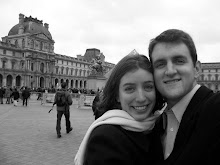.jpg) I dream of giving birth to a child who will ask, "Mother, what was war?" ~Eve Merriam
I dream of giving birth to a child who will ask, "Mother, what was war?" ~Eve Merriam.jpg) Early this morning we drove from Rouen to Paris to pick up Shari and Patrick from the Orly airport. It was wonderful to see them, and they were surprisingly chipper and alert after a long flight from Denver, Colorado. On our way back to Cherbourg we stopped by the American cemetery at Omaha beach. It was on this beach that American casualties were the highest on D-Day. It is the largest American WWII cemetery.
Early this morning we drove from Rouen to Paris to pick up Shari and Patrick from the Orly airport. It was wonderful to see them, and they were surprisingly chipper and alert after a long flight from Denver, Colorado. On our way back to Cherbourg we stopped by the American cemetery at Omaha beach. It was on this beach that American casualties were the highest on D-Day. It is the largest American WWII cemetery..jpg) 9,387 fathers and brothers (thirty-three pairs buried side by side) and four women are buried here. It is a very sober but peaceful place, where the gravity of war hits home. This bronze statue is the center of the Memorial: "The Sprit of American Youth Rising From The Waves."
9,387 fathers and brothers (thirty-three pairs buried side by side) and four women are buried here. It is a very sober but peaceful place, where the gravity of war hits home. This bronze statue is the center of the Memorial: "The Sprit of American Youth Rising From The Waves.".jpg) On June 6th, the 63rd anniversary of D-Day, Daniel received some moving e-mails from people that work at his site. They expressed their appreciation for what American (and other) servicemen did that day, and showed that they have not forgotten the devastating but important sacrifices of WWII.
On June 6th, the 63rd anniversary of D-Day, Daniel received some moving e-mails from people that work at his site. They expressed their appreciation for what American (and other) servicemen did that day, and showed that they have not forgotten the devastating but important sacrifices of WWII.In Flanders fields the poppies grow
Between the crosses, row on row,
That mark our place, and in the sky,
The larks, still bravely singing, fly,
Scarce heard amid the guns below.
~John McCrae
Between the crosses, row on row,
That mark our place, and in the sky,
The larks, still bravely singing, fly,
Scarce heard amid the guns below.
~John McCrae
 Two weeks after I arrived, we drove to Paris on a Friday morning for my medical visit, part of the requirements for living in France. We were in a hurry as we left that morning, so we didn’t have time to fix and eat breakfast. That reminded me of another time when we were in a hurry, when we decided to grab a pastry in town on our way out. We went to the local patisserie in nearby Beaumont-Hague, where Daniel got his favorite “pan chocolate” and I got a pastry with some raisins. Then we realized we needed something to drink, and since it was a cold morning we thought a coffee would be nice. We were still in a hurry, and so we stopped in a nearby café. Daniel knew better, but thought it would be worth a shot to see if we could get a coffee “to go.” He asked in perfect French, but the woman at the counter looked at him like he was crazy. She asked someone else, but neither of them could begin to understand why we would want to take their porcelain cups with us. They didn’t get the concept, even after Daniel explained that it would need to be a disposable cup. I don’t think the French in general can understand why anyone wouldn’t have at least the time to sit down and have a cup of coffee. I have yet to see anyone eating or drinking in their car here… That is just unfathomable.
Two weeks after I arrived, we drove to Paris on a Friday morning for my medical visit, part of the requirements for living in France. We were in a hurry as we left that morning, so we didn’t have time to fix and eat breakfast. That reminded me of another time when we were in a hurry, when we decided to grab a pastry in town on our way out. We went to the local patisserie in nearby Beaumont-Hague, where Daniel got his favorite “pan chocolate” and I got a pastry with some raisins. Then we realized we needed something to drink, and since it was a cold morning we thought a coffee would be nice. We were still in a hurry, and so we stopped in a nearby café. Daniel knew better, but thought it would be worth a shot to see if we could get a coffee “to go.” He asked in perfect French, but the woman at the counter looked at him like he was crazy. She asked someone else, but neither of them could begin to understand why we would want to take their porcelain cups with us. They didn’t get the concept, even after Daniel explained that it would need to be a disposable cup. I don’t think the French in general can understand why anyone wouldn’t have at least the time to sit down and have a cup of coffee. I have yet to see anyone eating or drinking in their car here… That is just unfathomable.




























.jpg)